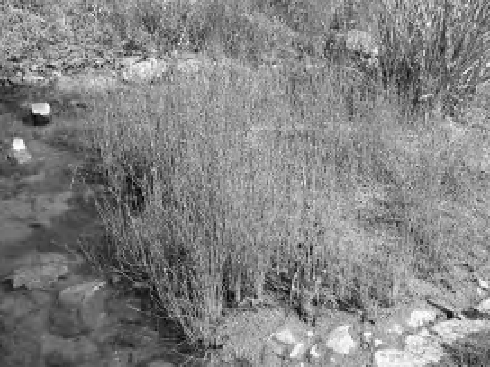Geoscience Reference
In-Depth Information
A
B
Figure 6-17.
Cluster of blunt spike rush (
Eleocharis
obtusa
) growing in a shallow stream channel. The
plants are about one foot (30 cm) tall. Photo by J.S.
Aber near Tishomingo, Oklahoma, United States.
of water willow is for stabilizing streambeds and
shorelines.
Spike rushes
(
Eleocharis
sp.) - Grasslike
plants that grow in clumps from 10 cm to 1.5 m
tall, depending on species (Fig. 6-17). Character-
ized by leal ess stems, each of which has a small
fruiting spike at the top. Spike rushes are quite
common in and diagnostic of wetland environ-
ments in temperate regions around the world.
They provide shelter for i sh, amphibians and
insects, and are a food resource for many
wetland birds and mammals.
Arrowheads
(
Sagittaria
sp.) - Several
common species, most of which are character-
ized by large, arrow-shaped or sagittate leaves,
standing up to 1 m above water (Fig. 6-18).
Leaves grow in dense clusters, and some species
grow large, starchy tubers at the ends of roots.
These bulbs are commonly known as duck pota-
toes and are prized by both wildlife and humans.
Nearly all parts of the plant are valuable as food
for waterfowl, songbirds, muskrat, porcupine
and beaver. Arrowheads have been introduced
in wildlife refuges to improve food resources,
and they are cultivated in China and Japan for
human food.
Bulrushes
(
Scirpus
sp.) - Bulrushes, among
the most benei cial emergent wetland plants,
are actually members of the sedge family.
They are found in all types of fresh and alkali
wetland settings
-
marshes, river banks, and
Figure 6-16.
Water willow (
Justicia americana
). A.
Carpet of water willow emerging from shallow water
along a lake shore. Plants stand 1-2 feet (30-60 cm)
above water level. B. Close-up view of bee on water
willow l ower. Photos by J.S. Aber and S.W. Aber; Lake
Kahola, Kansas, United States.
level. In this zone, the water level is more
dependable, but still subject to intermittent or
seasonal l uctuations. Because water level and
chemistry are more stable, this zone is often
densely covered with hydrophytes. This cate-
gory is recognized by most people as wetland
plants without question, simply because the
plants grow in water and emerge above the
surface where they are easily visible.
Water willow
(
Justicia americana
) - Erect
stems with opposed, willow-shaped leaves, for
which the plant is named (Fig. 6-16). Small,
orchidlike, white l owers bloom on long-
stemmed spikes and attract many insects.
Roots are usually submerged in shallow water
along stream or pond margins. Greatest value







